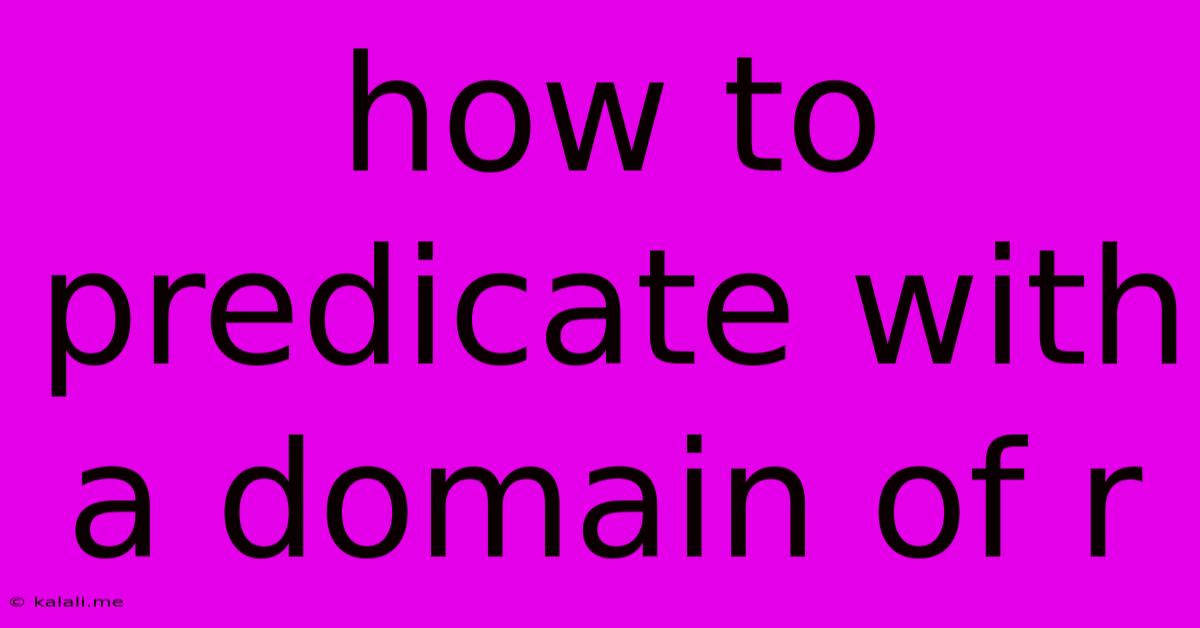How To Predicate With A Domain Of R
Kalali
May 23, 2025 · 3 min read

Table of Contents
How to Predicate with a Domain of ℝ (The Real Numbers)
Predicates are fundamental to mathematical logic and computer science. They're essentially statements about variables that can be either true or false depending on the value of those variables. This article explores how to work with predicates, focusing specifically on those with a domain of ℝ (the set of real numbers). Understanding this will allow you to express and analyze a wide range of mathematical concepts formally.
What is a Predicate?
A predicate is a function that maps its input (usually one or more variables) to a truth value – either true (T) or false (F). For example, P(x): x > 5 is a predicate. If we substitute x with 6, P(6) is true; if we substitute x with 3, P(3) is false. The domain of a predicate specifies the set from which the variables can take their values. In our case, focusing on a domain of ℝ means our variables represent real numbers.
Examples of Predicates with a Domain of ℝ:
P(x): x² ≥ 0: This predicate is true for all real numbers x because the square of any real number is always non-negative.Q(x, y): x + y = 10: This predicate is true only for pairs of real numbers (x, y) that sum to 10. It involves two variables.R(x): x is a rational number: This predicate is true for all rational numbers within the real numbers. It highlights the subset relationship between rational and real numbers.S(x): sin(x) = 0: This predicate is true for specific values of x where the sine function equals zero (multiples of π).
Quantifiers and Predicates:
To make broader statements about predicates, we use quantifiers:
- Universal Quantifier (∀): "For all" or "For every."
∀x ∈ ℝ, P(x)means "For all x in the set of real numbers, P(x) is true." - Existential Quantifier (∃): "There exists" or "There is at least one."
∃x ∈ ℝ, P(x)means "There exists at least one x in the set of real numbers such that P(x) is true."
Examples with Quantifiers:
∀x ∈ ℝ, x² ≥ 0: This statement is true; the square of every real number is non-negative.∃x ∈ ℝ, x > 100: This statement is true; there exist many real numbers greater than 100.∀x ∈ ℝ, x³ = x: This statement is false; not all real numbers satisfy this equation.∃x ∈ ℝ, x² + 1 = 0: This statement is false; there is no real number whose square plus 1 equals 0 (the solution is in the complex numbers).
Negation of Quantified Predicates:
Negating quantified predicates involves swapping the quantifier and negating the predicate:
- ¬(∀x ∈ ℝ, P(x)) ≡ ∃x ∈ ℝ, ¬P(x)
- ¬(∃x ∈ ℝ, P(x)) ≡ ∀x ∈ ℝ, ¬P(x)
Working with Multiple Quantifiers:
Predicates can involve multiple quantifiers. The order is crucial. For example, ∀x ∈ ℝ, ∃y ∈ ℝ, x + y = 0 (for every x, there exists a y such that their sum is 0) is true, but ∃y ∈ ℝ, ∀x ∈ ℝ, x + y = 0 (there exists a y such that for every x, their sum is 0) is false.
Applications:
Predicates with a domain of ℝ are extensively used in:
- Calculus: Defining limits, continuity, and differentiability.
- Real Analysis: Formally expressing properties of functions and sequences.
- Numerical Analysis: Developing algorithms for approximating solutions to equations.
- Computer Graphics: Representing geometric shapes and transformations.
By understanding how to construct, analyze, and manipulate predicates with a domain of real numbers, you gain a powerful tool for expressing and reasoning about mathematical concepts with precision and rigor. This foundation is crucial for more advanced mathematical studies and computational applications.
Latest Posts
Latest Posts
-
How Much Does A Water Bottle Weight
Jul 03, 2025
-
How Many Inches Is Half A Yard
Jul 03, 2025
-
How Old Are You If Your Born In 1996
Jul 03, 2025
-
How Many Water Bottles In 64 Ounces
Jul 03, 2025
-
How Many Cups Is 16 Oz Of Peanut Butter
Jul 03, 2025
Related Post
Thank you for visiting our website which covers about How To Predicate With A Domain Of R . We hope the information provided has been useful to you. Feel free to contact us if you have any questions or need further assistance. See you next time and don't miss to bookmark.